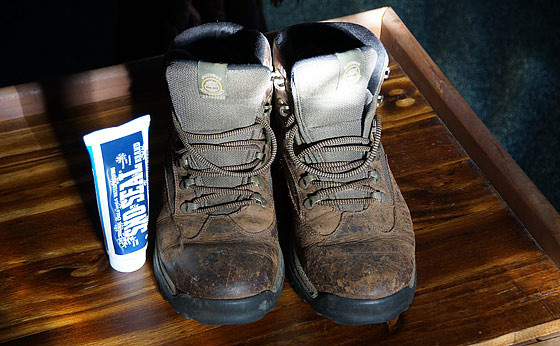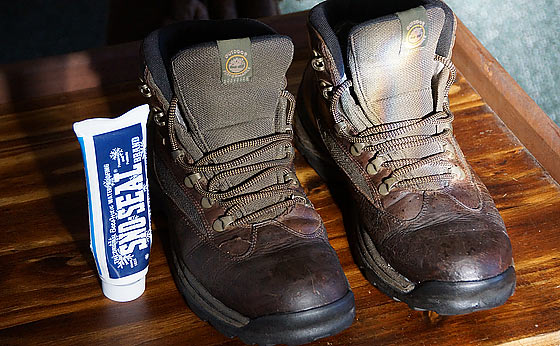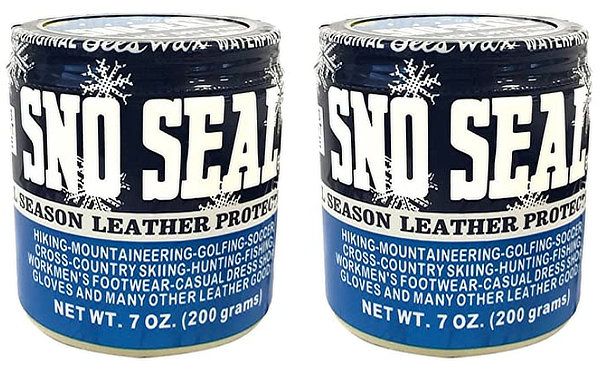Sno Seal Beeswax Instructions For Waterproofing Boots

I use Sno Seal beeswax to waterproof the leather on my boots. I have been waterproofing boots with beeswax for many years. So I thought that I would write up a quick post on the best way to apply Sno Seal. Instructions below.
I have a number of various pairs of boots. You can see a picture of my crusty Timberland leather work boots above. The photo was taken before I applied a Sno Seal maintenance coat. The boots were in obvious need of some protection and waterproofing.
Did you know that maintenance is a huge part of prepping & preparedness? I don’t care what it is… maintenance is important! When it comes to boots, beeswax such as Sno Seal is cheap insurance to help keep your feet dry – and to protect the leather on your boots.
Here’s a picture of those boots after Sno Seal application:
The beeswax creates a protective coating that should last approximately a year..
While the picture above still shows the leather’s wear-and-tear, the boots are now coated and penetrated with a soft beeswax that will keep the moisture out. The boot leather was so dry, I will probably apply beeswax a second time.
The Sno Seal instructions say to apply as much as the leather will absorb.
Note that the leather appearance will become a shade or two darker (just so you know).
What is Sno Seal?
It is really made from Bee’s Wax. Not grease or oil or some other product.
It’s made in the USA by a company named ‘ATSKO’, located in Orangeburg, SC.
Original Beeswax Waterproofing
(amzn)

What’s Good About Sno Seal For Waterproofing?
Sno Seal is acclaimed superior from the combination of its ability to remain fixed in the outer layer of the leather, and the excellent water resistance of Beeswax. It dries to a solid wax that remains on the surface.
Grease, oil, animal fat, and many other wax formulas are liquid (or at least soft enough to migrate thru leather). Many say that they’re not as good as beeswax because they soak away from the surface and migrate through the leather.
Beeswax provides just enough lubrication to prevent hardening of leather in typical use.
It maintains flexibility in freezing temperatures.
Sno Seal Instructions
How to apply Sno Seal to your boots.
First, clean your boots. Common sense, right? Towel off any dirt…
Then, using a circular motion, rub the beeswax (Sno Seal) into your boots with a clean, soft cloth. An old cotton T-shirt works well. I use a small piece of cotton (cut from an old t-shirt).
TIP: It helps to warm up your boots first so the beeswax absorbs more readily (e.g. with a hairdryer or leave them in front of the wood stove or radiator, etc..). It does help, although I’ve done it both ways (with and without pre-heating).
Apply a thick coat of the wax and be sure the boots are covered completely, paying special attention to the toe and heel. I apply it especially thick to the seam-sole areas. You might consider using a toothbrush, Q-tip or soft scrub brush to work the beeswax into the seam.
Set the boots aside until no longer tacky or wet to the touch, or overnight to allow the beeswax to penetrate the leather completely.
In the morning, remove any excess wax with a cloth.
(You can also get it in a tube)
(amzn)
Note: Even if you have purchased a pair of “waterproof boots,” the factory waterproofing may wear off quickly. So, don’t forget to waterproof them yourself too. Each time you clean the boots, reapply a waterproof seal.
[ Read: A Good Pair of Work Boots ]
[ Read: Best Ice Cleats for Shoes and Boots ]
